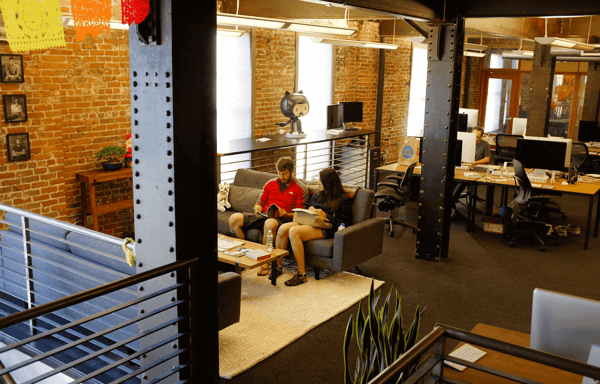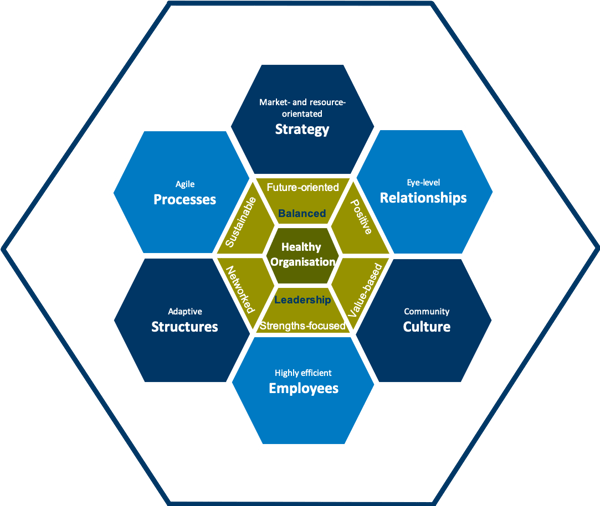New working environments (part 1) - room and quality
"The working spaces dominated by economic rationality overshadow the quality of life of the people who work there, they produce endless frictional losses for the companies and they prevent the shaping of society". John Nisberg
The hectic office life in the context of digitalization and globalization is pushing more and more employees to the limits of their capacity. Many companies complain of a loss of up to 50 percent of their personnel costs. Burn-out, depression and the inner dismissal of employees are on the increase. Are there factors that unconsciously aggravate and negatively fuel this burden?
The latest study (2019) by the Gensler Research Institute once again provides interesting insights into work behaviour in Germany. 2,250 office workers were surveyed.
As a result of the study it becomes clear that the working environment shows a considerable need for change because it inhibits cooperation and innovation. In addition, employees have high expectations of health and well-being, and the existing rooms alone cannot meet these expectations. The majority of employees would like to have open, communal rooms with opportunities for retreat.
The study makes it clear that changes in the areas of the working environment - the space in its immediate vicinity - play an important role alongside work organisation and work technologies.

The neurobiologist Gerhard Hüther comes to a similar conclusion: "I research living brains and therefore know that the dopamine axis in the head bubbles the most when people are enthusiastic and outgrow themselves, and this usually happens when the quality in the environment and the quality in handling is right.
Therefore, in our new series "New Work - New Working Environments" we dedicate ourselves to the requirements of the working environment, the quality in the environment, and the needs of the employees, the quality in dealing, in the 21st century in the overall context of our perspective of a healthy organization.
Looking back on the origins of the working world, the focus was on a completely different one. The term "bureau" originally comes from the film cover developed by monks to protect their most precious good, the book. In later times this became a space that served not only to protect books, but to protect what is even more precious than books - the protection of human beings.
Today, little of this precious original idea can often be felt, because the majority of companies are dominated by an economic rationality that is primarily focused on profit and efficiency. Negative stress, depression and anxiety are error messages that indicate deficits in the human environment. These are the symptoms that are perceived as a loss of motivation. This loss of motivation massively affects people's quality of life, causes enormous frictional losses in companies and also damages society.
Prof. Götz Werner, founder of dm, said about the motivation: "I cannot force my employees to motivate, but I can create the circumstances to motivate". If you look at a healthy organization in this context, you can see that the environment factor, i.e. the space and how the work environment is designed, has an impact on all areas of a healthy organization.

Figure 1: Healthy organisation - quality in the environment
The space has noticeable effects on all 7 dimensions of a healthy organisation. This will be explained in the following by means of short examples and will be examined more intensively in the context of the further series.
Relationships at eye level:
Individual offices can fuel arrogant relationships. The sense of community takes a back seat; information is not openly exchanged. The classic: the luxurious executive floor, where the employee from the lower floors is quoted to receive "feedback".
Community culture:
In order to create a collaborative culture, culture must be reflected as a part of daily life. Cross-hierarchical spaces for social exchange, common food or exercise opportunities promote a common culture.
A cool sofa is useless if it is not supposed to be used, since it could give the impression that you are not working on it. That's why it's important - especially in companies with a strong hierarchical structure: Managers set a good example and take advantage of the opportunities offered by the new workspaces.
Efficient employees:
Every person is different. This is called personal preferences. And everyone has different activities in the course of a working day, such as concentrated work, telephoning, talking, etc. This is called working modes. Intelligently designed, multifunctional rooms do justice to these different preferences and working modes. In this way, employees develop their full potential and efficiency.
Adaptive structures:
The company seems sluggish and reacts only slowly to market changes. Bureaucratic structures determine everyday working life.
Cross-functional teams in project or network structures are suitable for rapid exchange among each other and fast, competent decisions that are made close to the market. Rooms and workplaces can make this possible. These rooms breathe, so that smaller as well as larger teams always find the right place for exchange and togetherness.
Agile processes:
Agile working requires visualization, iteration loops and workshop-like working possibilities. Agile processes: Agile processes require visualization, iteration loops and iteration loops, and workshop-like working opportunities. Single or double offices are completely unsuitable. Larger visualizations using Scrum or Kanban boards are only possible in open spaces with the appropriate material.
Market- and resource-oriented strategy:
Strategy is the totality of all activities of the organization for the sustainable achievement of the organizational purpose as well as the goals derived from it. A sustainable strategy is untrustworthy if it is only reflected on paper, but not in reality, e.g. through the sustainability of the building.
The often strategically proclaimed phrase "Our focus is on the employee" can become just as clear here as a well thought-out customer focus that manifests itself in the construction of the building. The choice of company location can also send a clear signal.
Conclusion:
Since our society is constantly changing, the world of work is forced to adapt to these changes. To turn it positive: Crusted structures break open and create space for new thinking, action and the development of potential.
The quality of the environment and the quality of our dealings are key drivers for the employees in today's office. The infrastructure of today's offices usually lags behind the requirements of these needs.
The importance of space and the quality of the way we deal with it has a considerable influence on the motivation of employees and on all other dimensions of a healthy organisation.
Companies therefore do well to become aware of this connection, to redesign working environments and to make investments in order to offer their employees prosperous framework conditions in which commitment and growth are possible. It is the motivated and efficient employees who make long-term competitiveness possible.
Literature
Lehnen, C. Götz Werner in conversation: "Employees are not cost factors" In: Human Resources, At: https://www.personalwirtschaft.de/fuehrung/artikel/interview-goetz-werner-new-work-experience-2018.html (published on 02.04.2018)
Hüther, G.: (2015) A little more brains, please: An invitation to rediscover the joy of one's own thinking and the joy of shaping together, Vandenhoeck & Ruprecht
Kallenbach, I. (2016). Leadership in Healthy Organization. Exceptional performance through potential development. Stuttgart: Schäffer-Poeschel
Kulick, A.; Quarch, C., Teunen, J.: (2017) Oficina Humana: The office as living space for potential development, avedition
Quarch, C.; Teunen, J.: The office - a room with soul: In: FAZ online, Under: https://www.faz.net/aktuell/beruf-chance/beruf/serie-anders-arbeiten-ein-raum-mit-seele-15356932.html (published on 01.01.2018)

